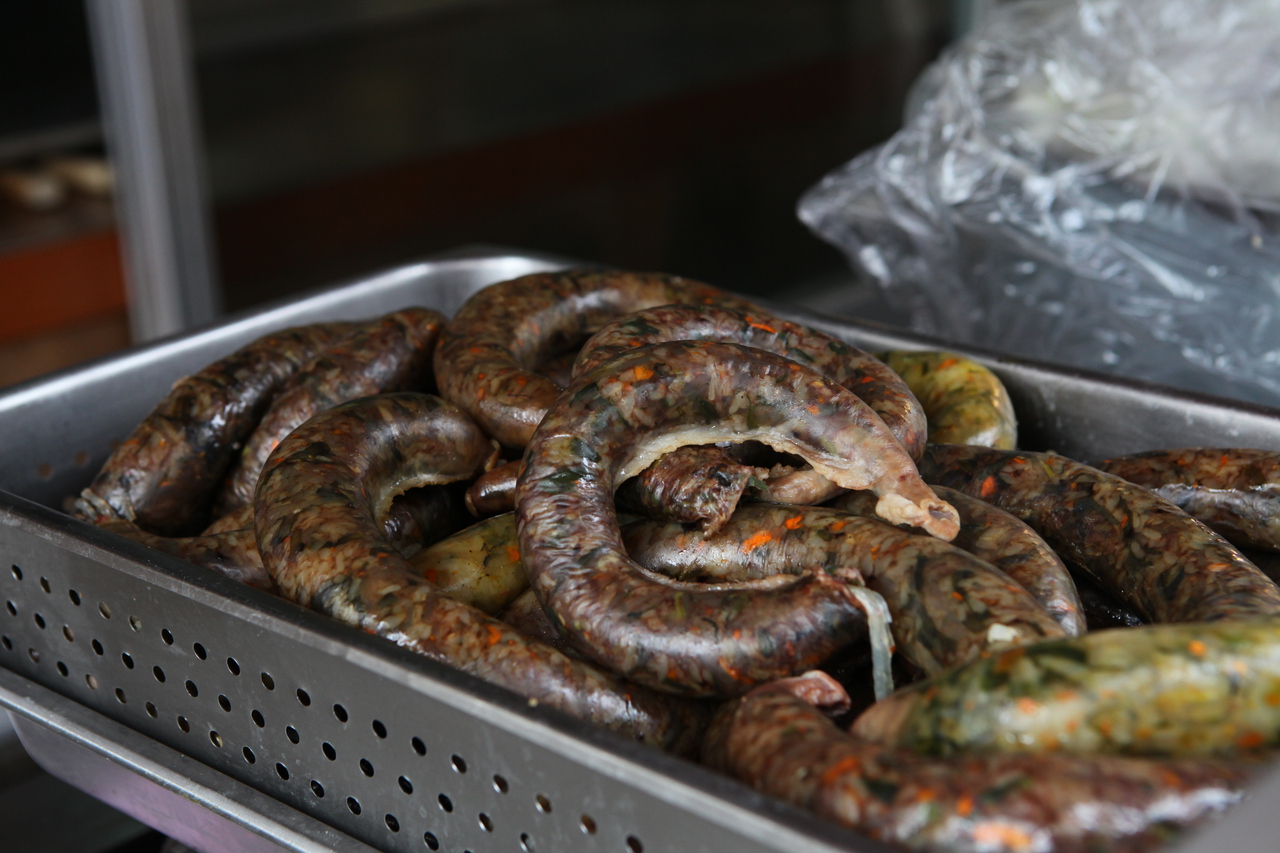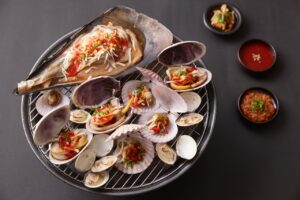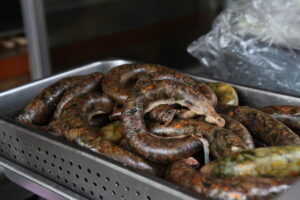
Sundae ⓒ한국관광공사 사진갤러리-이범수
Blood Sausage, Sundae
In Korean cuisine, a “sundae” (also spelled “soondae” or “sundae”) is not a sweet ice cream dessert but rather a type of traditional Korean blood sausage. Sundae is made from a mixture of ingredients, including pig’s blood, rice, and various seasonings, stuffed into a natural casing, often made from pig intestines. The sausage is then steamed or boiled until fully cooked.
Sundae is a popular street food in South Korea, and it is also commonly served at restaurants specializing in Korean cuisine. It is known for its unique texture and flavor. The rice and blood mixture inside the sausage casing creates a soft and slightly chewy texture, and the seasonings add a savory and slightly spicy taste.
There are several regional variations of sundae in South Korea, and the specific ingredients and seasonings used can vary from place to place. Some variations may include additional ingredients like mung bean noodles, garlic, and vegetables.
One of the most famous types of sundae is “sundae guk” (sundae soup), which is made by slicing the sundae sausage into pieces and serving it in a flavorful soup. This dish is enjoyed as a hearty and comforting meal, especially during colder months.
Sundae is a distinctive and culturally significant food in Korean cuisine, and while it might not be to everyone’s taste, it is an integral part of the country’s culinary heritage. If you have the opportunity to try sundae, it can provide a unique and authentic experience of Korean street food and traditional flavors.
History
Sundae (순대) in Korean cuisine refers to a type of blood sausage. It’s different from the American dessert sundae. The history of sundae in Korean cuisine is quite fascinating and dates back centuries. Here is a brief overview of the history of sundae (순대) in Korean cuisine: Ancient Origins: The roots of sundae can be traced back to ancient Korea. Blood sausages have been made in Korea for hundreds of years, with the practice dating back to at least the Three Kingdoms period (57 BC – 668 AD).
Ingredients and Preparation: Traditional Korean sundae is typically made using pig’s intestines, pig’s blood, glutinous rice, and various seasonings. The ingredients are mixed together and stuffed into the intestine casing, creating a distinctive texture and flavor.
Regional Variations: Sundae has regional variations in South Korea. Different regions may have their own unique recipes and variations. For example, there are Sundae-guk (soup) dishes where the sundae is sliced and served in a flavorful broth.
Street Food: Sundae has been a popular street food in South Korea for a long time. You can find street vendors and food stalls selling sundae in many parts of the country. It’s often enjoyed as a quick and satisfying snack.
Cultural Significance: Sundae has cultural significance in Korean cuisine. It is often associated with traditional holidays and celebrations. It’s also considered comfort food and is enjoyed during special family gatherings.
Modern Adaptations: In modern times, sundae has evolved, and there are various adaptations and fusion dishes that incorporate sundae. It’s not just limited to street food; you can find it on the menus of restaurants and eateries across South Korea.
Export and Popularity: With the growing interest in Korean cuisine worldwide, sundae has gained some recognition outside of Korea. Korean restaurants in various countries may include sundae on their menus.
Challenges and Health Considerations: The production and consumption of sundae have faced challenges related to health and hygiene concerns. Regulations and practices have been put in place to ensure safe production. The nutritional aspects of sundae have also been a subject of interest and discussion.
Sundae (순대) is a distinctive and culturally significant dish in Korean cuisine. It reflects the culinary traditions of Korea and has continued to evolve and adapt to changing tastes and preferences over the years. If you’re interested in exploring this topic further, you can delve into the various regional recipes, cultural traditions, and contemporary adaptations of sundae in South Korea.

Various Dishes with
Sundae (순대) in Korean cuisine is a versatile ingredient that can be used in a variety of dishes. Here are some of the most popular and delicious dishes that incorporate sundae: Sundae Bokkeum (순대볶음): Sundae is often stir-fried with vegetables and various seasonings to make Sundae Bokkeum. It’s a savory and slightly spicy dish that’s commonly served as a side dish or a snack.
Sundae Guk (순대국): Sundae can be sliced and used as an ingredient in a flavorful soup, known as Sundae Guk. The soup is typically made with a rich broth and various seasonings, making it a warm and comforting meal.
Tteokbokki (떡볶이): Tteokbokki is a popular Korean street food made with rice cakes and a spicy gochujang-based sauce. Sundae is often added to tteokbokki, providing a unique texture and flavor to the dish.
Sundae Deopbap (순대덮밥): Sundae Deopbap is a rice bowl dish where sliced sundae is served over a bed of rice and drizzled with a flavorful sauce. It’s a filling and satisfying meal.
Jeon (전): Sundae can be used as an ingredient in Korean pancakes known as “jeon.” These savory pancakes are made by dipping sundae and other ingredients in a batter and frying until crispy.
Sundae Gimbap (순대김밥): Sundae can also be used as a filling for gimbap, which are Korean rice rolls wrapped in seaweed. Sundae gimbap combines the flavors of sundae with rice, vegetables, and seasonings.
Sundae Skewers: Sundae can be threaded onto skewers and grilled or roasted, often brushed with a flavorful sauce. This makes for a delicious and convenient street food or appetizer.
Sundae Tteok (순대떡): Sundae can be combined with rice cakes to create a unique and tasty dish. The combination of chewy rice cakes and savory sundae is a popular choice.
Sundae Fried Rice (순대볶음밥): Sundae can be diced and used as an ingredient in fried rice. Sundae fried rice typically includes vegetables, seasonings, and, of course, sundae for a distinctive flavor.
Sundae Stew (순대찌개): Sundae can also be added to Korean stews. Sundae stew combines the flavors of sundae with tofu, vegetables, and a flavorful broth.
These are just a few examples of the many ways sundae can be incorporated into Korean cuisine. Its unique texture and savory flavor make it a versatile and beloved ingredient in various Korean dishes, both traditional and modern.
…
…
…
Recommend to Read >>> Tofu in Korea





